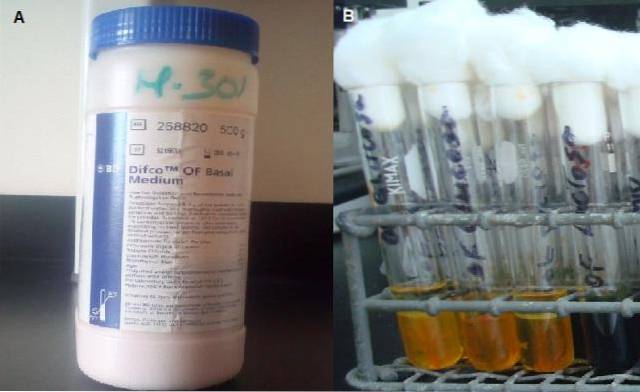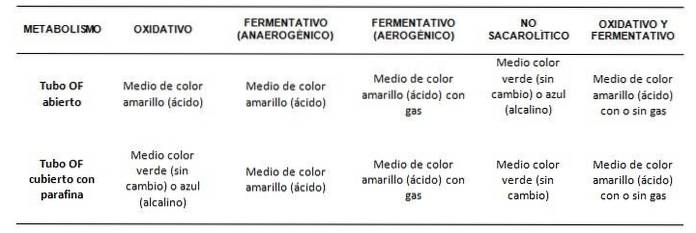
Medium OF foundation, preparation, uses and limitations
The medium OF or glucose fermentation agar is a semi-solid agar specially designed for the study of the oxidative and fermentative metabolism of carbohydrates in an important group of microorganisms other than Enterobacteriaceae, called non-enteric Gram negative bacilli.
It was created by Hugh and Leifson; these researchers realized that conventional means of studying acid production from carbohydrates were not suitable for this specific group of bacteria.

This is because non-enteric Gram negative rods generally produce low amounts of acids, unlike Enterobacteriaceae..
In this sense, the OF medium has special characteristics that can detect the small amounts of acid formed, both by oxidative and fermentative routes. These differences are related to the amount of peptones, carbohydrates and agar..
This medium contains less peptones and a higher concentration of carbohydrates, thus reducing the products that alkalize the medium as a result of protein metabolism and increasing the production of acids due to the use of carbohydrates..
On the other hand, the decrease in the amount of agar favors the dissemination of the acid produced throughout the medium, in addition to allowing us to observe motility.
OF medium is composed of peptone, sodium chloride, bromothymol blue, dipotassium phosphate, agar, and a carbohydrate. The most common carbohydrate is glucose, but others can be used according to the one you want to study, such as lactose, maltose, xylose, among others..
Article index
- 1 Rationale
- 1.1 Oxidation process
- 1.2 Fermentation process
- 2 Preparation
- 3 Uses
- 3.1 Sowing
- 3.2 Interpretation
- 4 Quality control
- 5 Limitations
- 6 References
Basis
Like any culture medium, OF medium must contain nutritive substances that guarantee bacterial growth; these substances are peptones.
For its part, carbohydrate provides energy and at the same time serves to study the behavior of the microorganism against it, that is, it allows the bacteria to be classified as an oxidative, fermentative or non-saccharolytic organism..
OF medium contains a 1: 5 peptone / carbohydrate ratio as opposed to 2: 1 conventional media. This ensures that the amount of alkaline amines formed from the degradation of peptones does not neutralize the formation of weak acids..
On the other hand, the medium contains sodium chloride and dipotassium phosphate. These compounds osmotically stabilize the medium and regulate the pH respectively. Bromothymol blue is the pH indicator, which turns the color of the medium from green to yellow with the production of acid..
Some microorganisms can use carbohydrates through the oxidative or fermentation pathways, while others do not take either path..
This depends on the characteristics of each microorganism. For example, some strict aerobic microorganisms can oxidize certain carbohydrates, and facultative anaerobes can oxidize and ferment depending on the environment around them, while others do not oxidize or ferment carbohydrates (asacarolytic).
Finally, there is a modification of the OF medium recommended by the CDC that contains a special OF base with phenol red as an indicator..
Oxidation process
The glucose oxidation process does not require glucose phosphorylation, as does the fermentation process. In this case the aldehyde group is oxidized to a carboxyl group, resulting in gluconic acid. This in turn is oxidized to 2-ketogluconic.
The latter either accumulates or breaks down to two molecules of pyruvic acid. This system requires the presence of oxygen or some inorganic compound as the final electron acceptor..
The production of acids by this route is weaker than that obtained by the fermentation route.
Fermentation process
For glucose fermentation to occur by any of the available routes, it must first be phosphorylated, becoming glucose-6-phosphate.
The fermentation of glucose can take several routes, the main one is the Embden-Meyerhof-Parnas route, but they can also take the Entner-Doudoroff route, or the Warburg-Dickens route of hexose monophosphate, also known as the of the degradation of pentoses.
The route chosen will depend on the enzymatic system that the microorganism possesses..
Via Embden-Meyerhof- Parnas
In the fermentation of glucose by the Embden-Meyerhof-Parnas pathway, it is split into two triose molecules, to then be degraded to various carbon compounds, until reaching the formation of glyceraldehyde-3-phosphate. From there an intermediate substance originates, which is pyruvic acid..
From there, various types of mixed acids will be formed that can vary from one species to another..
This system occurs in the absence of oxygen and requires an organic compound as the final electron acceptor..
Entner-Doudoroff pathway
In the fermentation of glucose via the Entner-Doudoroff pathway, glucose 6-phosphate becomes glucono-ᵼ-lactone-6-phosphate and from there it is oxidized to 6-phosphogluconate and 2-keto-3-deoxy-6- phosphogluconate, to finally form pyruvic acid. This pathway does need oxygen for glycolysis to occur.
Pentoses degradation pathway or Warburg-Dickens Hexoxa monophosphate pathway
This route is a hybrid of the previous 2. It begins similar to the Entner-Doudoroff pathway, but later glyceraldehyde-3-phosphate is formed as a precursor of pyruvic acid, as occurs in the Embden-Meyerhof-Parnas pathway..
Preparation
Weigh:
2 g of peptone
5 g of sodium chloride
10 g of D-glucose (or the carbohydrate to be prepared)
0.03 g of bromothymol blue
3 gr of agar
0.30 g of dipotassium phosphate
1 liter of distilled water.
Mix all the compounds except the carbohydrate and dissolve in 1 liter of distilled water. Heat and shake until completely dissolved.
On cooling to 50 ° C, 100 ml of 10% glucose (filtered) is added.
Aseptically distribute 5 ml of OF medium into cotton-capped test tubes and autoclave at 121 ° C, 15 pounds pressure for 15 minutes.
Let solidify in a vertical position.
The pH of the medium should be 7.1. The color of the prepared medium is green.
Store in a refrigerator.
Applications
The OF medium is a special medium for determining the metabolic behavior of a microorganism against a carbohydrate. Especially for those that form little, weak or no acids.
Sown
For each microorganism, 2 OF tubes are needed, both must be inoculated with the microorganism to be studied. The colony is taken with a straight handle and a puncture is made in the center of the tube without reaching the bottom; several punctures can be done, as long as there is no interest in observing motility.
A layer of sterile liquid petrolatum or sterile melted paraffin (approximately 1 to 2 ml) is added to one of the tubes and is labeled with the letter "F". The other tube is left original and is labeled with the letter "O". Both tubes are incubated at 35 ° C and observed daily for up to 3 to 4 days..
Interpretation
Metabolism and gas production
Table: Classification of microorganisms according to their behavior in open (oxidative) and closed (fermentative) OF tubes

The gas is observed with the formation of bubbles or displacement of the agar.
It should be noted that an organism that only oxidizes glucose but does not ferment it, will not be able to ferment other carbohydrates either, in any case it will only oxidize it. Therefore, in this situation, the sealed tube for the study of other carbohydrates will be omitted..
Motility
Additionally, motility can be seen in the OF medium.
Positive motility: growth that is not limited to the area of inoculation. There is growth towards the sides of the tube.
Negative motility: growth only in the initial inoculum.
QA
The following strains can be used as quality controls: Escherichia coli, Pseudomonas aeruginosa Y Moraxella sp. The expected results are:
- coli: Glucose fermenter (both yellow and sparkling tubes).
- aeruginosa: Glucose oxidizer (yellow open tube and green or blue seal).
- Moraxella sp: Non-saccharolytic (green or blue open tube, green sealed tube).
Limitations
-Some microorganisms cannot grow in OF medium. In these cases, the test is repeated but 2% serum or 0.1% yeast extract is added to the medium..
-Oxidation reactions are often only observed close to the surface and the rest of the medium can remain green, similarly it is taken as positive.
References
- Koneman E, Allen S, Janda W, Schreckenberger P, Winn W. (2004). Microbiological Diagnosis. 5th ed. Editorial Panamericana S.A. Argentina.
- Forbes B, Sahm D, Weissfeld A. (2009). Bailey & Scott Microbiological Diagnosis. 12 ed. Editorial Panamericana S.A. Argentina.
- Mac Faddin J. (2003). Biochemical tests for the identification of bacteria of clinical importance. 3rd ed. Editorial Panamericana. Buenos Aires. Argentina.
- Francisco Soria Melguizo Laboratories. 2009. OF Glucose Medium. Available at: http://f-soria.es
- Conda Pronadisa Laboratories. OF glucose medium. Available at: condalab.com
- BD Laboratories. 2007. OF Basal Medium. Available at: bd.com



Yet No Comments